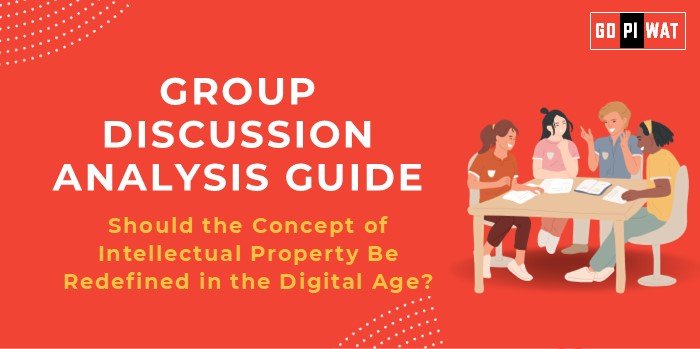📋 Group Discussion Analysis Guide: Should the Concept of Intellectual Property Be Redefined in the Digital Age?
🌐 Introduction to the Topic
- 📖 Opening Context: “The digital age has revolutionized how information is shared, consumed, and created, raising fundamental questions about the concept of intellectual property (IP).”
- 📜 Topic Background: Intellectual property laws originated to incentivize creativity by granting creators exclusive rights. However, rapid technological advances challenge these laws, making their applicability in the digital age a topic of heated debate.
📊 Quick Facts and Key Statistics
- 💰 Global Creative Economy: Valued at $2.25 trillion (2023), heavily reliant on IP protection.
- 🔒 Piracy Losses: Online piracy caused $29.2 billion in global revenue loss for creative industries in 2022.
- 🤝 Open Source Growth: 78% of companies use open-source software, showcasing a shift in collaborative creation.
- 🌐 Digital File Sharing: 42% of internet users admit to sharing copyrighted material in some form.
👥 Stakeholders and Their Roles
- 🏛️ Governments: Regulate and enforce IP laws, adapt frameworks for the digital age.
- 🏢 Corporations: Innovate new technologies and advocate for their IP protections.
- 🎨 Content Creators: Balance protection of their works with the broader accessibility demands.
- 🛒 Consumers: Drive demand for accessible and affordable content, challenging traditional IP frameworks.
- 🌍 Global Organizations: WIPO (World Intellectual Property Organization) works to standardize IP protections across borders.
📈 Achievements and Challenges
🏆 Achievements
- ✨ Rise of Creative Commons, enabling legal sharing of content.
- 💻 Improved revenue streams for creators via digital platforms (e.g., Spotify, YouTube).
- 📄 International treaties like the Berne Convention remain relevant but evolving.
⚠️ Challenges
- 🔓 Online piracy and content theft.
- 🌍 Inequity in global IP enforcement between developed and developing nations.
- 🧠 Ethical concerns about monopolization of knowledge (e.g., pharmaceuticals, academic publications).
🌍 Global Comparisons and Case Studies
- 🇺🇸 United States: Strong IP laws; recent lawsuits (e.g., Oracle vs. Google) highlight digital complexities.
- 🇨🇳 China: Struggles with enforcement; rapid tech growth outpaces legislative reforms.
- 🤖 Case Study: OpenAI’s chatbot innovations leverage copyrighted content, sparking debates over AI training data rights.
📋 Structured Arguments for Discussion
- 💡 Supporting Stance: “Redefining IP laws is essential to address the challenges posed by digital piracy and ensure creators are fairly compensated.”
- 🔍 Opposing Stance: “Existing IP frameworks can be adapted without redefinition, preserving global standards and minimizing disruptions.”
- ⚖️ Balanced Perspective: “While fundamental redefinition may not be necessary, incremental reforms addressing specific digital challenges are critical.”
🧠 Effective Discussion Approaches
🌟 Opening Approaches
- 📊 Data-Driven Start: “Online piracy cost industries $29.2 billion in 2022, raising questions about the efficacy of current IP laws.”
- 🔧 Problem-Solution Frame: “How can IP laws evolve to protect creators while promoting innovation?”
⚔️ Counter-Argument Handling
- 💬 Example: “Acknowledging criticisms, open-source models coexist with proprietary frameworks, proving adaptability.”
🔎 SWOT Analysis
- 💪 Strengths: Encourages innovation, protects creators, fosters global trade.
- 📉 Weaknesses: Complex enforcement in digital environments, regional disparities.
- 🌱 Opportunities: Leverage blockchain for digital IP protection, expand open-source ecosystems.
- ⚠️ Threats: Rising digital piracy, monopolistic practices.
🔗 Connecting with B-School Applications
- 📈 Real-World Applications: Explore themes like data monetization, ethical AI, and IP-driven business models.
- ❓ Sample Interview Questions:
- 💭 “How should companies balance IP protection and open innovation?”
- 🤔 “What role can technology play in modernizing IP laws?”
- 📘 Insights for Students: Examine case studies of disruptive IP conflicts and propose innovative solutions.


